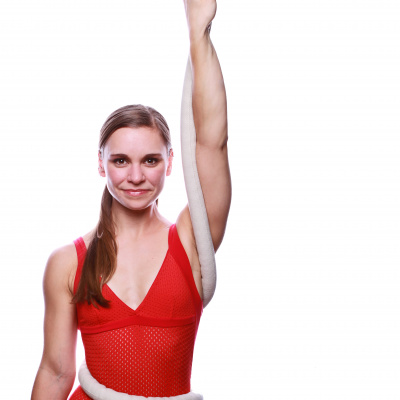The Simultaneous Creations of Diana & Delusional
Diana Salles and Firenza Guidi both have enormous smiles. They speak from the heart and listen patiently with unwavering, attentive eyes. Individually, they are charming, and together they are a riveting powerhouse of artistic drive. Guidi: “I do it because otherwise I would burst.” Salles: “It’s just this need of creating. You’re born with it.” Guidi: “If you don’t have that urge to get it out, why not go and play golf?” We laughed together with mutual understanding. They are deep in the creation process of Delusional: I killed a man, a new solo show starring Salles, directed by Guidi. “It’s a provocation—I killed a man—because of course,” Salles explained with her hand to her heart, “I loved that man. Maybe the man I’ve ever loved the most is Diego. That’s why I speak so openly about him. I hate him sometimes because I feel oppressed, but it wasn’t really the character [of Diego] – we are all characters. It’s more that I was so forced to be a man, be a man, be a man. Sometimes it’s a relief. Oh gosh! He’s gone! But also a burden. Did I kill him? In the end, Delusional is a thought-provoking show, a chance to connect, to explore, to cope. It’s a huge coping mechanism for me. I don’t know how I would be dealing as well with this transition if I wasn’t creating Delusional. [It] gives me the distance from my reality to digest and break it apart.”
Hailing from Brazil and Italy respectively, Salles and Guidi are internationally renowned, award-winning artists.Their paths collided working on Sabotage by NoFit State circus. “In many ways it’s a shame,” Guidi reflected, “that we don’t have that documentation. From the very first few shows, over an arch of four to five months, things really changed. Slowly—if people had been aware—they would have seen Diego’s costume changing, posture changing, body changing, relationships in terms of physical bodies on stage changing until,” she turned to Salles, who completed the sentence with a smile, “Diana.” “Diana,” Guidi repeated, “arrived and was born.”
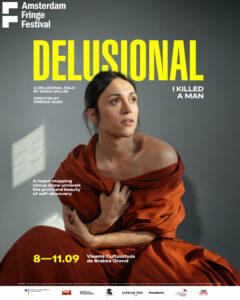
“I really didn’t want to transition. I know I’m transgender since I’m seven years old. It’s something that had been weighing on my shoulders my whole life,” Salles said, “and I’ve been running from it—eating the cake from the corners—to the point where I got used to the idea of being a very queer man, very effeminate. But transitioning is another level.” Salles described touring with NoFit State as a bubble. “The moment I started working for them, this transition started happening. It was like a baby was being born.Unconsciously, I realized, I’m safe – like I’d never felt before.” Guidi added, “The fact that the company tours like a traditional company—you’re living together, you’re eating together—there’s a bubble, as was described. It can work both ways of course, but it can really help. The support system is huge to bring someone to arrive at that decision.”
Salles continued, “The beginning of the transition, if you go deeper in psychology, it’s the hardest part for the trans person because you still have a lot of male [or female] features. The dysphoria is very strong. You don’t know yet how to dress yourself, what fits you or not. I went through the phase (the pink shoes, the dress!), and no one in NoFit State ever laughed at me. They were very supportive.” Salles turned to Guidi, “That’s beautiful, right? Even people that had never encountered trans people.” When Salles spoke to Tom Rack, Artistic Director, he said, “We will adapt and change with you.” Costumes were altered—no small feat for the eight characters Salles portrayed in the show. Salles noted, “It’s not only about the changing of the body, but it has an impact dramaturgically as well.” She concluded, “I didn’t feel like a trans person. I felt like any other performer, and that’s the dream for us to reach. That happened because it was NoFit State. I have never worked for someone like them. And I think circus [industry] needs more of this comprehension.”
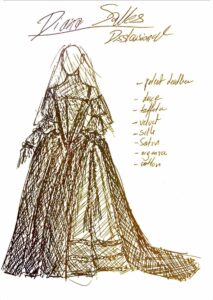
The synergy of Guidi and Salles meeting in such a supportive environment birthed Diana and their artistic relationship.Making Delusional is a dual creation process. Guidi described, “What is really important about this process is that it’s in the act of happening. It’s in theory. It’s in the process of. It’s not resolved yet; mixing the artistic discourse with the daily basis life discourse.” The appreciation for each other through both journeys is palpable. “Transitioning is very complex; I’ve been transitioning socially for a year and a half and at the same time producing a solo with all its complexity. I don’t know if anyone else would deal as majestically with me as she does,” Salles said of Guidi.
Both related stories of invoking Diego for legal purposes. “It came as a stab to me yesterday,” Guidi said, physically animated by the memory, “when our costumes were lost, and I heard Diana speak on the phone saying, This is Diego Salles. In the papers, she cannot say she is Diana Salles. When I heard that I thought, No Diana! No Diana! Don’t say that! Just remembering that on a daily basis, that contradiction, and having to say that name.” Salles added on, “It’s very painful and weird to be remembered by my documents because it triggers. It puts me out of line. So after the call,” she turned, looking for a ghostly presence, “I was like, Is he here?! It brings back this entity.”
Salles also related a few stories of public aggressions she has experienced. “These reminders, they break you inside. If you’re not treated with kindness it’s hard to be like, It’s fine. No! You have aggression!” These moments haunt her, but through artistic conversations they become inspiration. “Every time something hard happens, we use it,” Salles explained. “This show helps a lot to throw some shit out the window,” she said with a laugh. Guigi reflected, “It was interesting in these conversations to hear Diana say, If I wasn’t an artist I would probably go mad.” Guidi paused, choosing her next words carefully, but Salles unabashedly jumped in. “We can say it: I probably would have killed myself. It’s horrible to say it, but,” she gestured, indicating it was fact.
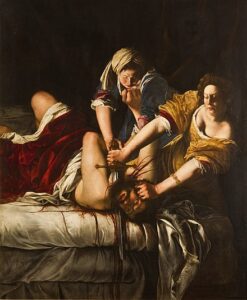
While Delusional is inspired by Salles’ transition, the work is not autobiographical. As the dossier states, “The show is narrated by a `Neo’ version of Judith, a character from Caravaggio’s famous painting (Judith Beheading Holofernes, painted in c. 1598–1599). The artist and activist Diana Salles embodies Judith to conduct her delusions. Through her character she shares her thoughts, stories, anger, and joy with the public.” It is “[a] journey about overcoming your past in order to be free. It is a show about rebirth.” And it concludes, “There isn’t rebirth without death.”
Guidi expanded on the show’s subtitle, I killed a man. “We are still trying to debate if that man, Diego, has been killed or where he lives in Diana. But it’s a huge and incredible issue to transform into art. I think that both of us agree that it’s not about washing your dirty linen in public. It’s not about moaning or complaining. There are a lot of things which are painful on a daily basis, a lot of things that can relate to a lot of people in the world that are going through the same thing. It’s not that I’m just proud of the work—because she’s an incredibly talented performer—it’s also the depth of research with beauty, passion, commitment right to the core.” Salles echoed her, saying they are not interested in lecturing people. “It’s more about showing parts of this path and how it reflects on me as an artist, how the transition is more than changing the clothes, making surgeries. The process of leaving Diego behind was and is still really hard.”
Grief, loss, and mourning: timely themes that everyone can relate to. Guidi made a striking-through gesture, “Art should be transversale,” she said in Italian. “It should speak to everyone. It should cut through.” Salles noted, “It’s really focused on letting this man go and le deuil—in French—when someone dies, the mourning.” While these themes are widely experienced and may prompt the audience into a state of catharsis, Salles also noted, “Empathy. My biggest goal of the show is for people to relate. We can all relate to change in our lives. The transition itself – when I am in my four walls, my house – it’s beautiful!” Her whole posture expanded with joy, a sense of flight. “It’s been incredibly nice! To try the clothes I want, or to see my body change to match how I feel. It’s the outside that hurts, that makes it difficult.” She continued, “The questions that transition brings—and I have to speak only of my own experience—I think are questions many of us have of our own sexuality, our gender, our place in society.I just wish that people would see that, see the things I’ve been going through, and say, Oh. It’s not a trans woman. It’s a person, just like us.”
Guidi’s take on the show is that “it’s incredible what it can say to other people [transitioning], but also to the world at large. It’s not just [trans people who will] possibly be empowered, but it’s also society that needs to learn how to deal with people that are trans. That is an enormous decision in anybody’s life to make! Unfortunately, we are still living discrimination on a daily basis. People watching, people gazing in the street, ways of changing the tone of voice. I think it’s society at large that needs to learn the most.”Delusional is not crafted to instruct (or as Guidi said, ram it down people’s throats); it is simply invoking the power of well-made art to empower people and create empathy.
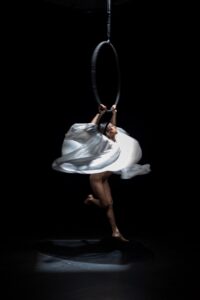
I asked Salles and Guidi, besides the fact that Salles is a circus artist, what is the medium of circus bringing to the story? Salles replied first. “What makes me stick with circus is that I feel included. Meaning, circus is not made for one part of society. Circus is a marginalized art that through the years is for everyone. What better art form to speak about transcending and growing and changing than circus? I truly believe circus can get very political if used well.” She said, “I don’t think it would be such a strong path to everyone if it was made in dance or theater. Circus brings other colors: the risk, the danger, the acrobat bodies, the way that it’s made. It’s reachable. Everyone can reach and take it. My love for the art form lies there.” And Salles wasn’t shy to say what I think most performing artists feel, “I love leaving the stage feeling that I left something there and also feeling like I rocked the shit out of it!”
For Guidi, “Risk is the big word for circus and the body. The two things together. If it had been a text-based show, it would have probably developed by other means. The immediacy of the body; that is readable. Being a dramaturg of the body, I believe firmly that bodies tell stories without sometimes needing many words. Stories that speak more subliminally to different levels and different people. The body is also the starting point of gender.”
Salles and Guidi were gracious as I stumbled through formulating a question that has irked me since the beginning of this series: what needs to happen for a series about women, a show about a trans person, an interview about the female experience, to simply be art rather than a restorative symbol, a filler for a historical hole due to underrepresentation?
Salles replied, “I feel big support. At times it feels like a celebration of femininity and masculinity. At times it feels very political. Undeniably, I am a living political body. It’s written on my forehead. Everywhere I go it’s a show. At times it feels empowering. The system is imperfect but the system makes good things. At some point it needs to break down, so we can rebuild it.”
Earlier in the conversation when Salles described her time with NoFit State she said, “It’s all about environment. We talk about inclusion of trans people, or queer people, or any gendered political representation that we want on the stage, but we forget that it’s not only about having it on the stage. Companies also need to discuss their safety net—their way of approaching and speaking with their company and directors. By a miracle, or by the heavens, everyone in NoFit State dealt very well, but I don’t think it would have been that way in other places even though they say they are inclusive.” Salles also noted that “My career in circus went really well, but it suffocated me. I don’t think circus is ready for anyone to transition. And so that’s why I am also doing it. So that the next ones, and everyone in my network can see: Oh yeah! It’s possible. Remember Diego? It can happen. I’m not the only one. There are other trans people leading this, but I definitely see, oh wow, I’m in the front.” With more conversations, more voices, more community, she said, “We have more chances to reach more empathy and justice.”
Salles is ever-optimistic and full of love. “I truly believe in humanity, and that’s funny to hear from a trans woman. But I believe in people so much. I think, these people in the street when they are looking at me, deep down, they don’t want to harm me. We have way more good people than bad people. I truly believe that with time and understanding, this utopia will be there. But we have a lot to do, and we have to do it now.”
DELUSIONAL: I killed a man is proudly supported by the Zirkus ON Creative Alliance, which is funded by the Commissioner for Culture and Media of the Federal Government of Germany through the Promoting Connections program of the Federal Association of Independent Performing Arts (BFDK).
To support Delusional: I killed a man, please visit https://gofund.me/1e330b4b. To learn more about Diana Salles, please visit www.dianasalles.com or find her on Instagram: @sallees
Do you have a story to share? Submit your news story, article or press release.


